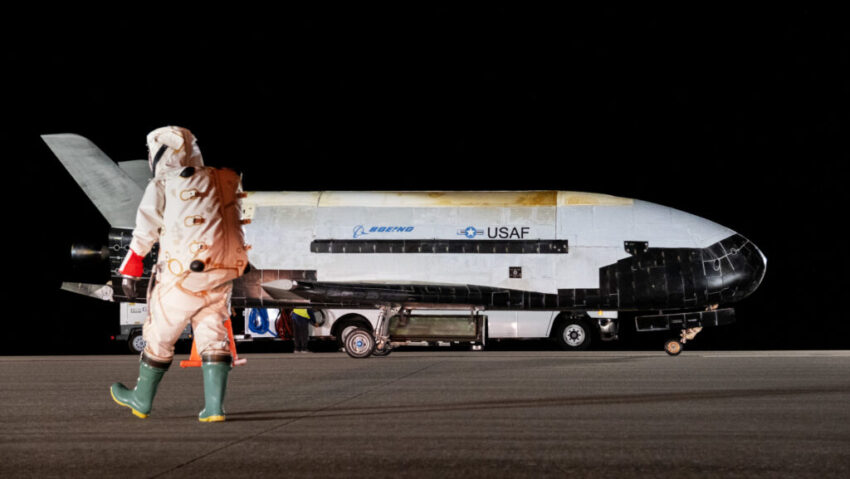X-37B orbital test vehicle concludes sixth successful mission, November 2022. (Space Force photo by Staff Sgt. Adam Shan)
WASHINGTON — The Defense Department’s secretive X-37B Orbital Test Vehicle will lift off again in late August, carrying a quantum sensor that could enable navigation when GPS is unavailable as well as a laser communication system, the Space Force announced today.
The Aug. 21 mission will be the eighth for the mysterious space plane, which is operated by the Space Force in partnership with the Air Force Rapid Capabilities Office. The X-37B returned to Earth from its previous mission on March 7, having spent 434 days in low Earth orbit (LEO). During that flight, the space plane performed a first-ever series of aerobraking maneuvers to change its orbit around Earth and safely dispose of its service module components.
Quantum sensors hold promise to serve as the core for new systems for positioning, timing and navigation (PNT) that could provide an alternative, or even replace, today’s Global Positioning System satellites. US military leaders, particularly in the Army, are increasingly worried about the increasing vulnerability of GPS to jamming and spoofing by adversaries, not to mention the more mundane but still serious problem of losing signals in mountainous terrain and so-called urban canyons.
Quantum sensors for PNT use atomic accelerometers or gyroscopes that measure acceleration and rotation by shining lasers into small clouds of atoms (usually rubidium) contained in vacuum chambers. The sci-fi-sounding tech exists, but the tricky part is making the sensors small enough and robust enough for use on not just on satellites, but on ships, aircraft, vehicles and even in soldiers’ backpacks.
The X-37B quantum inertial sensor experiment “is a welcome step forward for operational resilience in space,” Col. Ramsey Horn, Space Delta 9 commander, said in the Space Force release. “Whether navigating beyond Earth-based orbits in cislunar space or operating in GPS-denied environments, quantum inertial sensing allows for robust navigation capabilities when GPS navigation is not possible.”
Space Delta 9 is the Space Force unit charged with orbital warfare, according to the service’s website.
The experimental quantum sensor to be tested on board the X-37B was developed for the Pentagon’s Defense Innovation Unit (DIU) under a contract to Vector Atomic, a California startup focused on commercializing use of atomic instruments, a Space Force spokesperson told Breaking Defense today.
For the X-37B’s second new mission, the Space Force also is keenly interested in using optical data links both for satellite-to-satellite and satellite-to-ground communications. Using light waves allows more data to be transmitted in one go than today’s radio frequency-based data links, the Space Force press release explains.
“Additionally, they are more secure than traditional radio frequency transmissions owing to the more targeted nature of laser beams,” it adds.
Indeed, the Space Development Agency planning its LEO-based data transport and missile tracking constellations around use of laser communications. DIU also is working with the Air Force Research Laboratory to develop a “hybrid space architecture” of commercial and military satellites for a “hack proof” internet in space that also would rely on optical communications.
Chief of Space Operations Gen. Chance Saltzman stated that the X-37B’s laser demonstration “will mark an important step in the U.S. Space Force’s ability to leverage proliferated space networks as part of a diversified and redundant space architectures. In so doing, it will strengthen the resilience, reliability, adaptability and data transport speeds of our satellite communications architecture.”
Click this link for the original source of this article.
Author: Theresa Hitchens
This content is courtesy of, and owned and copyrighted by, https://breakingdefense.com and its author. This content is made available by use of the public RSS feed offered by the host site and is used for educational purposes only. If you are the author or represent the host site and would like this content removed now and in the future, please contact USSANews.com using the email address in the Contact page found in the website menu.





